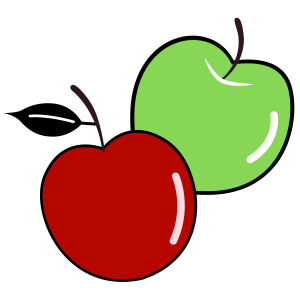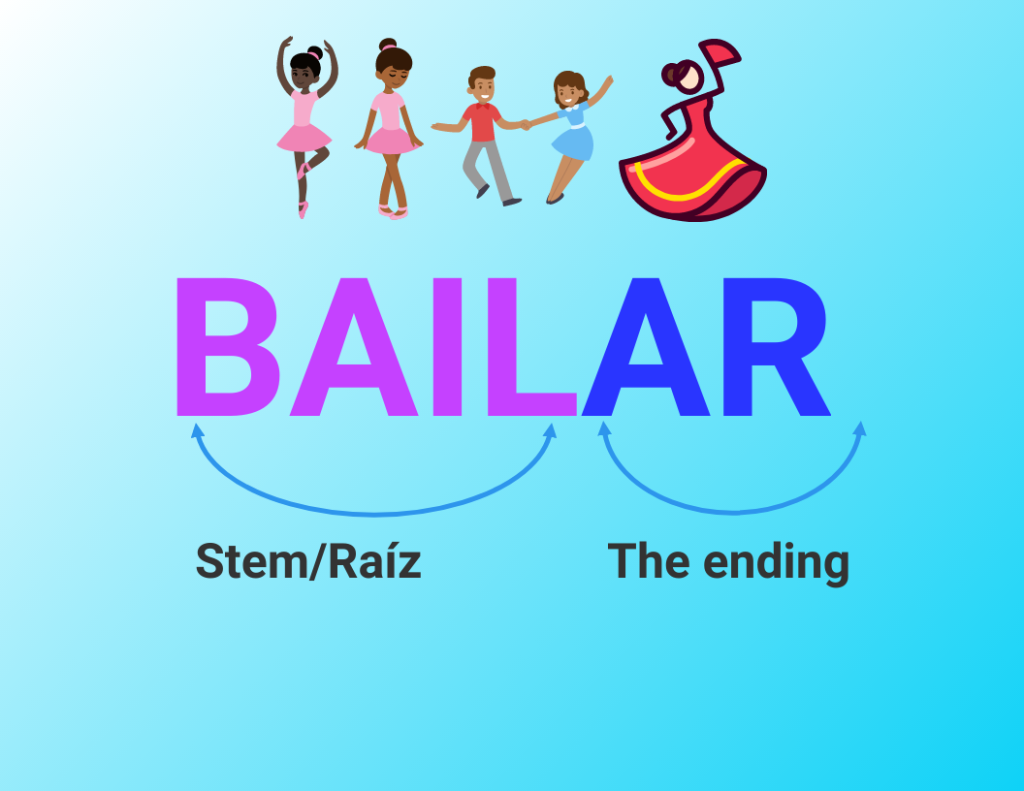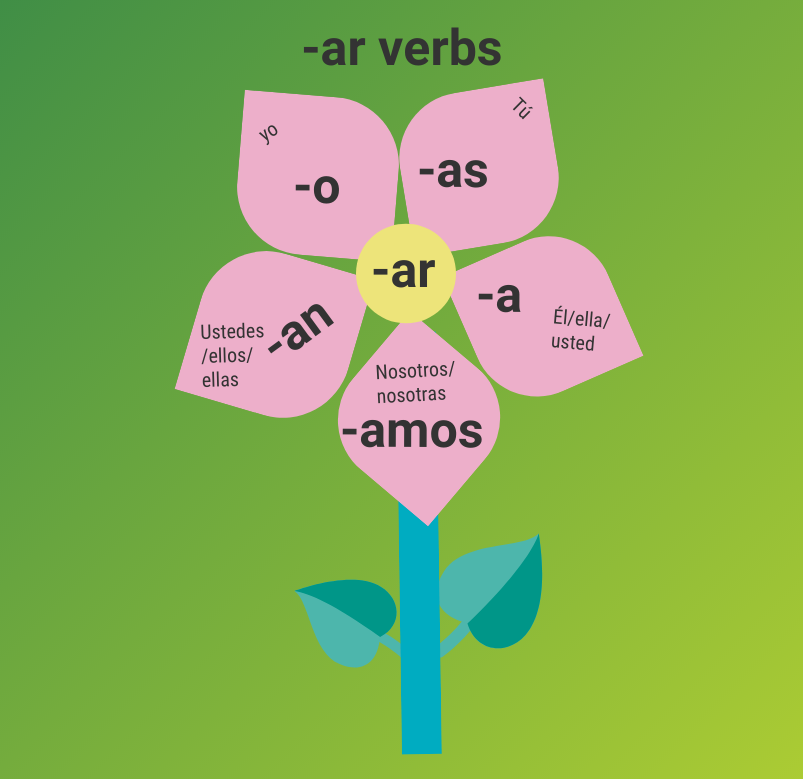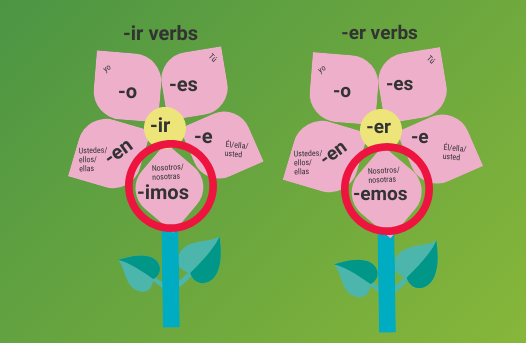Unidad 3 – Segunda Parte (Part 2)
Vocabulario
(Vocabulary)
Las profesiones y ocupaciones (Professions and occupations)
Las profesiones y ocupaciones[1] can function as both sustantivos y adjetivos.
| Profesiones as nouns: | Profesiones as adjectives: |
| La/ una profesora | María es profesora. |
| El / un artista | Sofía es artista. |
| Los/ unos doctores. | Julio y Alejandra son doctores. |
| Las / unas ingenieras | Yo y mi hermana somos ingenieras. |
As sustantivos you are just identifying professions. As adjetivos you are describing what people do for a living.
In la primera parte of this unit 2 you learned the following descriptive adjetivos:
- las descripciones físicas (Physical descriptions)
- las características de la personalidad (Personality traits)
- las descripciones de las estapas de la vida (Life changing event descriptions)
- las nacionalidades (Nationalities)
When used as adjetivos, las profesiones y ocupaciones must also agree with the person´s gender (masculino, femenino) and number of people (singular, plural).
Some profesiones y ocupaciones used as adjectives are gender neutral so they apply for both genders, but they still must agree in number.
1. Profesiones y ocupaciones (with gender agreement):

Study the vocabulary list of las profesiones y ocupaciones below to learn what they mean in English. Click on search and find more profesiones y ocupaciones.
| English | Spanish | masculino | - | femenino |
|---|---|---|---|---|
| Accountant | El | contador | La | contadora |
| Actor/actress | El | actor | La | actriz |
| Administrator | El | administrador | La | administradora |
| Ambassador | El | embajador | La | embajadora |
| Archaeologist | El | arqueólogo | La | arqueóloga |
| Architect | El | arquitecto | La | arquitecta |
| Artist | El | artista | La | artista |
| Attorney | El | abogado | La | abogada |
| Baker | El | panadero | La | panadera |
| Barber | El | barbero | La | barbera |
| Bartender | El | mesero | La | mesera |
| Biologist | El | biólogo | La | bióloga |
| Builder | El | constructor | la | constructora |
| Businessperson | El | empresario | La | empresaria |
| Butcher | El | carnicero | La | carnicera |
| Captain | El | capitán | La | capitana |
| Carpenter | El | carpintero | La | carpintera |
| Clerk | El | oficinista | La | oficinista |
| Coach | El | entrenador | La | entrenadora |
| Computer programmer | El | programador de computadoras | La | programadora de computadoras |
| Cook | El | cocinero | La | cocinera |
| Dancer | El | bailarín | La | bailarina |
| Designer | El | diseñador | La | diseñadora |
| Doctor | El | doctor | La | doctora |
| Driver | El | conductor | La | conductora |
| Editor | El | editor | La | editora |
| Electrician | El | electricista | La | electricista |
| Engineer | El | ingeniero | La | ingeniera |
| Farmer | El | agricultor | La | agricultora |
| Firefighter | El | bombero | La | bombera |
| Geologist | El | geólogo | La | geóloga |
| Hotelier | El | hotelero | La | hotelera |
| Jeweler | El | joyero | La | joyera |
| Landlord | El | dueño | La | dueña |
| Lawyer | El | abogado | La | abogada |
| Librarian | El | bibliotecario | La | bibliotecaria |
| Mail carrier | El | cartero | La | cartera |
| Mechanic | El | mecánico | La | mecánica |
| Minister (church) | El | pastor | La | pastora |
| Minister (politics) | El | ministro | La | ministra |
| Nurse | El | enfermero | La | enfermera |
| Painter | El | pintor | La | pintora |
| Pharmacist | El | farmacéutico | La | farmacéutica |
| President | El | presidente | La | presidenta |
| Professor | El | profesor | La | profesora |
| Psychologist | El | psicólogo | La | psicóloga |
| Sailor | El | marinero | La | marinera |
| Salesperson | El | vendedor | La | vendedora |
| Scientist | El | científico | La | científica |
| Secretary | El | secretario | La | secretaria |
| Social worker | El | trabajador social | La | trabajadora social |
| Stylist | El | estilista | La | estilista |
| Surgeon | El | cirujano | La | cirujana |
| Teacher | El | maestro | La | maestra |
| Therapist | El | terapeuta | La | terapeuta |
| Translator | El | traductor | la | traductora |
| Veterinarian | El | veterinario | La | veterinaria |
| Waiter /Waitress | El | mesero | La | Mesera |
| Welder | El | soldador | La | soldadora |
| Writer | El | escritor | La | escritora |
| Zoologist | El | zoólogo | La | zoóloga |
2. Profesiones y ocupaciones (gender neutral):
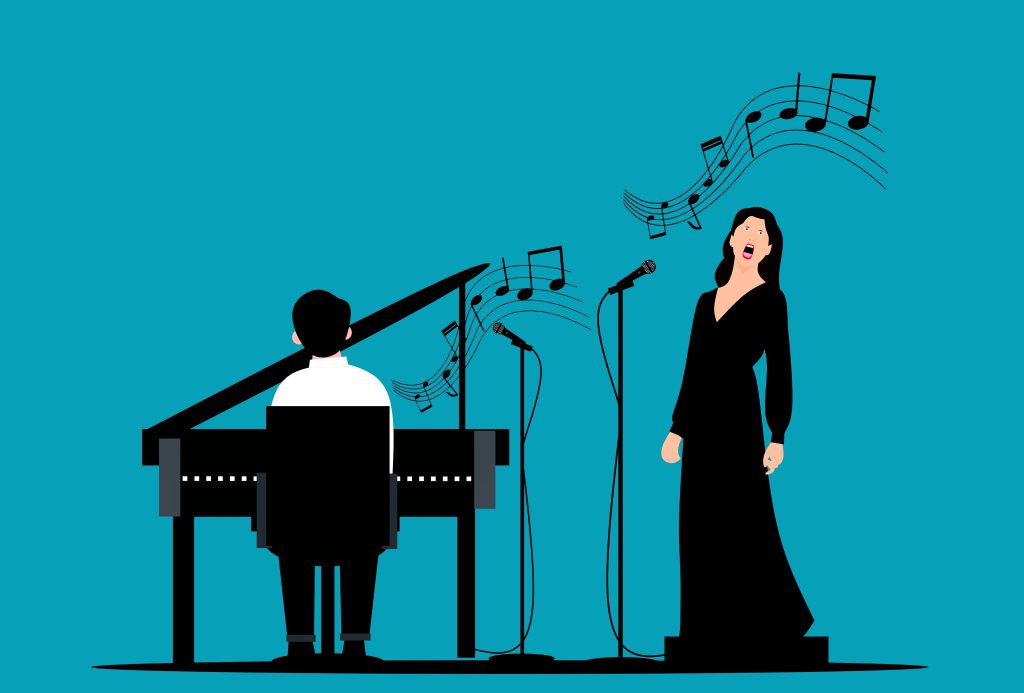
Study the vocabulary list of las profesiones y ocupaciones below to learn what they mean in English. Listen to the audio to learn how to pronounce them.
| English | Article | Ocupación |
|---|---|---|
| artist | el/la | artista |
| athlete | el/la | atleta |
| Beautician | el/la | esteticista |
| dentist | el/la | dentista |
| florist | el/la | florista |
| guard | el/la | guardia |
| investor | el/la | inversionista |
| journalist | el/la | periodista |
| manager | el/la | gerente |
| model | el/la | modelo |
| Pilot | el/la | piloto |
| poet | el/la | poeta |
| singer | el/la | cantante |
| soldier | el/la | soldado |
Cómo usarlo
(How to use it)
El verbo Ser is required when talking about current profesiones y ocupaciones.
- Yo soy doctora.
- Él es enfermero.
- Nosotros y nosotras somos carpinteros.
- Ellos y ellas son modelos.
Notice that when we describe the profession of a person we do not use the articles (la, una, el, un, las, unas, los, unos) in the sentence.
A good way to practice las profesiones y ocupaciones is asking each other about it. The following preguntas are used interchangeably to ask about profesiones y ocupaciones:
- ¿En qué trabajas?
- ¿Cuál es tu profesión?
- ¿Cuál es tu ocupación?
- ¿A qué te dedicas?
¡Más práctica!
Answer en español in full sentences using el verbo ser and el vocabulario de las profesiones y ocupaciones:
Copy and paste the following letters and symbols as needed.
á é í ó ú ñ Á É Í Ó Ú Ñ ¡ ! ¿ ?
- ¿En qué trabajas tú?
- ¿Cuál es la ocupación o profesión de tu papá o de tu mamá?
- ¿Cuál es la ocupación o profesión de tu mejor amigo/amiga?
Gramática
(Grammar)
1. Los artículos indefinidos y definidos en español
(Indefinite and definite articles in Spanish)
En la unidad 1 you learned that las palabras (the words) la / una means the / a, an in English when used with singular feminine objects or persons (nouns) in Spanish. You also learned that las palabras el / un means the / a, an in English when used with singular masculine objects or person (nouns) in Spanish.
En la unidad 2 you learned that la, una, el, un must be pluralized if the noun is plural as in:
- las / unas profesoras
- los / unos profesores
Las palabras un, una, uno, unas son artículo indefinidos (indefinite articles) en español.
Las palabras el, la, los, las son artículos definidos (definite articles) en español.
1. Los artículos indefinidos un, una, unos, unas
(Indefinite articles un, una, unos, unas)
| masculino | femenino | ||
|---|---|---|---|
| singular | un | singular | una |
| plural | unos | plural | unas |
Los artículos indefinidos are used when we don’t know too much about a noun. In English, we use: “a, an, some”.
Un libro. We know that it is masculino, singular, but we don´t know to whom it belongs or what is the subject of the book.
Unos libros. We know that it is masculino, plural, but we don´t know to whom they belong or what is the subject of the books.
Una mazana. We know that it is femenino, singular, but we don´t know to whom it belongs or what type of apple it is.
Unas manzanas. We know that it is femenino, plural, but we don´t know to whom they belong or what type of apples they are.
Cómo usarlo
(How to use it)
En la unidad 1 you learned that el verbo “tener” is required when talking about la posesión de objetos (possession of objects). You also learned that las palabras un, unos, una, unas are required to describe possessions.
Entonces, los artículos indefinidos are used when talking about la posesión de objetos with el verbo “tener”.
- Yo tengo un teléfono celular.
- Paulina tiene una mochila.
- Juan Peñatiene una tableta.
- Nosotrostenemos unas sillas y unos computadores portátiles.
En la unidad 2 you learned that la forma impersonal “hay” (there is/there are) is always followed by a specific quantity (numbers) or by the words un, una, unos, unas which is equivalent to the English words a, an, some.
Entonces, los artículos indefinidos are used when talking about the existence of a single object o person or the existence of 2 or more objects or persons.
- Hay un computador en la mesa. (There is a computer on the table)
- Hay una mujer en la calle. (There is a woman on the street)
- Hay unos hombres en la calle. (There are some men in the house)
- Hay unas sillas en la casa. (There are some chairs in the house)
2. Los artículos definidos el, la, los, las
(Definite articles el, la, los, las)
| masculino | femenino | ||
|---|---|---|---|
| singular | el | singular | la |
| plural | los | plural | las |
Los artículos definidos are used when we do know information about a noun. In English, we use “the”.
Cómo usarlo
(How to use it)
As you have learned so far los artículos definidos are used to identify nouns.
- La profesora.
- Los audífonos.
- El teléfono celular.
- Las casas.
- Los objetos y las personas.
As learned above, los artículos definidos are used to provide information about a noun.
- La profesora de español.
- Los audífonos son negros (black).
- El Primer Ministro de Canadá es Justin Trudeau.
- Las mujeres son de Bolivia.
En la unidad 2 you learned to express gustos y disgustos with el verbo gustar and similar verbs.
Entonces, los artículos definidos are used to talk about things we like and dislike.
- Me gustan los chocolates.
- A mi esposo le fascina el fútbol.
- No me interesa la política.
- A mí me encantan las flores.
2. El presente simple indicativo de los verbos regulares
(Simple present tense of regular verbs)
You already know that el presente simple indicativo en español tells that an action happens in the present. You have practiced this with los verbos ser, estar, and tener en el presente simple indicativo which are considered irregular verbs en español as they don´t follow a pattern of conjugation.
Unlike ser, estar y tener, los verbos regulares en español can be put into three categories depending on their ending:
- Verbos regulares ending in -ar:
- cantar (to sing), caminar (to walk), sociablizar (to socialize), estudiar (to study), etc.
- Verbos regulares ending in -er:
- beber (to drink), correr (to run), leer (to read), comprender (to comprehend), etc.
- Verbos regulares ending in -ir:
- vivir (to live), asistir (to attend), escribir (to write), abrir (to open), etc.
There are about 20,000 verbs in Spanish of which about 18,000 are regular verbs, meaning that they follow a pattern when we conjugate them.
Haz clic en el enlace que sigue to learn more verbs:
En la unidad 2 you learned una lista de vocabulario de actividades. You learned that las actividades son verbos and they were presented to you in infinitivo.
Like in English, the infinitive form of a verb en español means that the verb is not yet conjugated. Look at the following image to learn the components of an infinitive verb en español:
Unlike in English, the ending of an infinitive verb en español tells us what type of verb it is. Depending on the ending, the regular verb en español will follow a common pattern of conjugation in the present tense.
| Bailar (to dance) | |
| Yo | bailo |
| Tú | bailas |
| Él, Ella, Usted | baila |
| Nosotros, Nosotras | bailamos |
| Ellos, Ellas, Ustedes | bailan |
As you see from the example of el verbo bailar conjugated en el presente simple indicativo (simple present tense) above, the stem will not change, but the ending must be taken out and apply the patterns of conjugation for verbs ending in –ar in the simple present tense. This exercise will repeat itself depending on the ending of the infinitive verb en español.
Let´s look at the patterns of conjugation for the simple present tense of regular verbs:
1. El presente simple indicativo de verbos regulares -ar en español
(Simple present tense of regular verbs -ar in Spanish)
To conjugate -ar verbs en presente simple indicativo we need to remove the -ar ending and apply the following pattern of conjugation:
Vocabulario:
- la raíz (the stem)
- la terminación (the ending)
- Bailar : Bail (raíz), ar (terminación)
| Pronombres Sujeto | bailar |
|---|---|
| Yo | bailo |
| Tú | bailas |
| Él, Ella, Usted | baila |
| Nosotros, Nosotras | bailamos |
| Ustedes, Ellos, Ellas | bailan |
¡IMPORTANTE!
Because in Argentina, Uruguay, Paraguay and some countries in Central America, tú changes to vos, then the pattern of conjugation tú _as will change to vos _ás.
- tú bailas (you-informal dance) will change to vos bailás.
Because in Spain and Equatorial Guinea ustedes changes to vosotros / vosotras, then the pattern of conjugation ustedes _an will change to vosotros / vosotras _áis.
- ustedes bailan (you-all dance) will change to vosotros / vosotras bailáis.
The following table shows una lista de verbos regulares con terminación -ar that you can use to practice el presente indicativo:
| Español | English |
|---|---|
| amar | to love |
| ayudar | to help |
| bailar | to dance |
| cambiar | to change |
| cantar | to sing |
| cocinar | to cook |
| comprar | to buy |
| descansar | to rest |
| entrar | to enter |
| esperar | to wait |
| ganar | to win |
| gastar | to spend |
| hablar | to speak |
| limpiar | to clean |
| llamar | to call |
| llevar | to take, to carry |
| mirar | to watch, to look |
| nadar | to swim |
| olvidar | to forget |
| pagar | to pay |
| preparar | to prepare |
| tomar | to take, to drink |
| trabajar | to work |
| viajar | to travel |
¡Más práctica!
Responde las preguntas que siguen about yourself en español and in a full sentence using el presente indicativo de los verbos -ar studied:
Copy and paste the following letters and symbols as needed.
á é í ó ú ñ Á É Í Ó Ú Ñ ¡ ! ¿ ?
- ¿Viajas todos los años?
- ¿Trabajas?
- ¿Tomas te o café?
- ¿Cocinas bien o mal?
- ¿Tocas algún instrumento?
- ¿Cantas en la ducha?
- ¿Estudias mucho?
2. El presente simple indicativo de verbos regulares -ir y -er en español
(Simple present tense of regular verbs -ir and -er in Spanish)
Los verbos regulares -ir and -er en español share the same pattern of conjuation en el presente simple indicativo except in the pronouns nosotros / nosotras as highlighted in the picture below:
- Vivir (Viv (raíz), ir (terminación)
- Beber (Beb (raíz), er (terminación)
| Pronombres Sujeto | vivir | beber |
|---|---|---|
| Yo | vivo | bebo |
| Tú | vives | bebes |
| Él, Ella, Usted | vive | bebe |
| Nosotros, Nosotras | vivimos | bebemos |
| Ustedes, Ellos, Ellas | viven | beben |
¡IMPORTANTE!
Because in Argentina, Uruguay, Paraguay and some countries in Central America, tú changes to vos, then the pattern of conjugation tú _es for -ir verbs will change to vos _ís and for -er verbs will change to vos -és.
- tú vives (you-informal live) will change to vos vivís.
- tú bebes (you-informal drink) will change to vos bebés.
Because in Spain and Equatorial Guinea ustedes changes to vosotros / vosotras, then the pattern of conjugation ustedes _an will change to vosotros / vosotras _éis.
- ustedes viven (you-all live) will change to vosotros / vosotras vivéis.
- ustedes beben (you-all drink) will change to vosotros / vosotras bebéis.
The following 2 tables show una lista de verbos regulares con terminación -ir and -er that you can use to practice el presente simple indicativo:
| Español | English |
|---|---|
| asistir (a) | to attend (to) |
| compartir | to share |
| confundir | to confuse |
| decidir | to decide |
| describir | to describe |
| descubrir | to discover |
| discutir | to argue |
| escribir | to write |
| existir | to exist |
| permitir | to permit |
| recibir | to receive |
| subir | to upload, to go up |
| vivir | to live |
| Español | English |
|---|---|
| aprender | to learn |
| barrer | to sweep |
| beber | to drink |
| comer | to eat |
| comprender | to understand |
| correr | to run |
| creer (en) | to believe (in) |
| deber | should, ought, must |
| leer | to read |
| meter | to put, to insert |
| prender | to turn on |
| romper | to break |
| temer | to fear, to dread |
| toser | to cough |
| vender | to sell |
3. Resumen del presente simple indicativo de los verbos regulares -ar, -er-, ir en español
(Summary of the simple present tense of regular verbs ending in -ar, -er, ir in Spanish)
Mira el video que sigue that summaries el presente simple indicativo de los verbos regulares -ar, -er, ir, en español:
¡A practicar!
¡ATENCIÓN!
Remember that when using el verbo gustar y verbos similares that express gustos y disgustos we don’t conjugate the second verb as gustar is already conjugated.
- Me gusta bailar.
- A mi hermano le gusta pintar y practicar fútbol.
When writing sentences conjugating actividades en el presente simple indicativo you can do so as follows:
| Oraciones (sentences) en presente indicativo: | ejemplos: |
|---|---|
| If you have a period (.) | Yo bailo. Yo canto. Yo corro. |
| If you have a comma (,) | Yo bailo, canto, corro… |
| If you have the word “y” (and) | Yo bailo y canto. |
| If you have a comma and the word "y" (and) | Yo bailo, canto, corro y camino. |
| If you have the word “pero” (but) | Yo bailo, pero no canto. |
| If you have the words “o” (or) | Yo bailo o canto. |
| If you have the word "después" (after) | Yo bailo. Después yo canto. Yo bailo y después yo canto. |
| If you have the word "antes" (before) | Yo bailo. Antes yo canto. Yo bailo pero antes yo canto. |
Remember that for la negación (negation) you must add “no” before the conjugated verb.
- Yo no bebo tequila.
- Tú no vives en España.
- Ellos no trabajan en el supermercado.
- Ustedes no comen carne (meat) porque son vegetarianos.
Based on actividades you do and don´t do, write a sentence for each possible sentence above using -ar, -er and – ir verbs.
Copy and paste the following letters and symbols as needed.
á é í ó ú ñ Á É Í Ó Ú Ñ ¡ ! ¿ ?
¡Más práctica!
En la unidad 2 you watched el video of the song Nunca el tiempo es perdido (Time is Never Waisted) del cantante español Manolo García. You had to make una lista de 10 actividades en infinitivo you saw in the video, and also make a list of 10 objetos you also saw in the video.
Mira el video otra vez y describe what people do or don´t do using el presente simple indicativo de los verbos regulares studied. You can build upon the list of actividades en infinitivo you worked on en la unidad 2 and now conjugate them en el presente simple indicativo. Be thorough! The more you practice the better equipped you will be to control el presente simple indicativo de los verbos regulares studied.
Copy and paste the following letters and symbols as needed.
á é í ó ú ñ Á É Í Ó Ú Ñ ¡ ! ¿ ?
Cultura hispanohablante
(Spanish-speaking Culture)
Diversidad étnica en el mundo hispanohablante
(Ethnic diversity in the Spanish-speaking world)

En la unidad 1 you learned that las personas hispanohablantes are ethnically diverse due to thousands of years of cultural contact as a result of human migration and colonization.
Your learned that as a result of el contacto cultural, las personas hispanohablantes carry apellidos that reflect this cultural contact.
También, as a result of el contacto cultural las personas hispanohablantes portray different skin colours.
In the media, ethnically diverse hispanohablantes are not always portrayed especially las personas de ascendencia indígena and afrolatinos.
Relación entre lengua y cultura (Language and culture relationship)
El contacto cultural also affects the language or languages we speak. El español is not an exception.
Aquí hay some examples of words used en español that come from other languages:
| Language | Word used en español |
|---|---|
| Latin | Rosa |
| English | mosquito |
| Italian | maestro |
| Náhuatl | aguacate |
| English | patio |
| Arabic | alcohol |
¿Sabías que…? (Did you know…?)
El español is also known as el castellano?
Haz clic in the following enlace to learn about los nombres el español y el castellano used to call the Spanish language:
¡A aprender más!
The following video is a chronological map showing linguistic evolution in Southwest Europe. You will see how el castellano (Castilian) evolved and took over in the region.
As you saw en el video, the Arabic language was of great influence in the region before the expansion of el castellano o el español. Due to this evolution, the Arabic language has greatly influenced the Spanish language. En español o en castellano, there are approximately 1000 words if not more that are derived from the Arabic languages or have Arabic roots.
Haz clic in the following enlace to learn about the influence of the Arabic language on el español o el castellano:
En mi opinión…
Do your own search to look up some of the words that el castellano o el español has adopted from el árabe into everyday use in Spanish. Can you see some similarities in the words that come from el árabe? Reflect in English.
Think of the language or languages you speak. Do they also have words with different lexical backgrounds? Can you think of any words in Spanish that have been adopted into English? Reflect in English.
Media Attributions
- Occupations © Photographer Ade Akinrujomu is licensed under a CC BY (Attribution) license
- Piano-pianist-singer-jazz-music-concert-1640921-pxhere.com © Mohamed Hassan is licensed under a CC0 (Creative Commons Zero) license
- Red Book © Konemru is licensed under a Public Domain license
- Book Pack © crisg is licensed under a Public Domain license
- Apple © OpenClipart is licensed under a Public Domain license
- Apples © Openclipart is licensed under a Public Domain license
- The parts of a Verb: Stem and Ending © Ana Robles is licensed under a CC BY-NC (Attribution NonCommercial) license
- Verbos Regulares -ar in flower croped © Ana Robles is licensed under a CC BY-NC (Attribution NonCommercial) license
- Verbos Regulares -ir and -er in flower croped © Ana Robles is licensed under a CC BY-NC (Attribution NonCommercial) license
- Group of happy and diverse volunteers © rawpixel.com is licensed under a CC0 (Creative Commons Zero) license
- Other words to describe the job you do are: la ocupación, el empleo, la profesión, el trabajo, el oficio. ↵
nouns
adjectives
for example
and
words used before nouns to generally describe the identity and quantity of a noun.
questions
let´s practice!
more practice!
then, hence
street
likes
dislikes
regular verbs
click on
link
what follows, below
activities
verbs are words that represent an action or activity. For example: "to sing" is an action in infinitive form. In the sentence "I sing" the action is conjugated in the present indicative. In the sentence "I sang" the action is conjugated in past tense.
infinitive, any verb or action that is preceded by the word 'to' in English is an infinitive. For example: to love, to eat, to run, to be, to believe, to follow, to laugh, etc. This means that the actions are not yet conjugated in the present tense or in any other tense.
stem - of a verb
the ending - of a verb
present simple indicativo (simple present tense)
answer
that follow
look at, watch
attention!
the present indicative (present tense)
objects
one more time, again
describe
cultural encounter, cultural contact
last names
also
Indigenous ancestry
Spanish-speaking people of African descent.
here
there is / there are
let´s learn more!
or
in my opinion
Arabic




